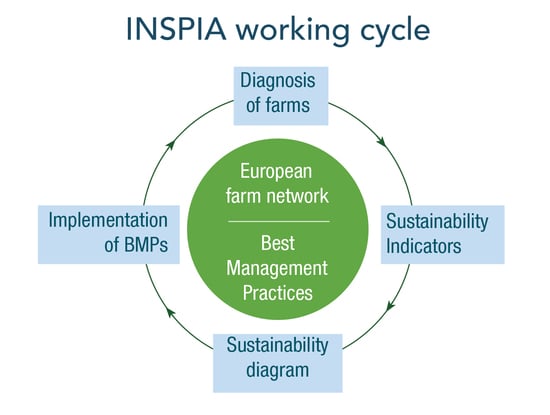Sustainability Assessment of Annual and Permanent Crops: The Inspia Model
Abstract
1. Introduction
2. Materials and Methods
2.1. The Method for Selecting the BMPs and Indicators
2.2. INSPIA—Best Management Practices
2.3. INSPIA Sustainability Indicators
2.3.1. Indicator Development
2.3.2. Normalisation of Indicators
2.3.3. Weighting of Indicators
2.3.4. Aggregation of Indicators
2.4. INSPIA Sustainability Composite Index
2.5. INSPIA Online Tool
3. Results
3.1. Set of INSPIA BMPs
3.2. INSPIA Sustainability Indicators
3.3. INSPIA Aggregated Indicators
3.4. INSPIA Sustainability Index
4. Discussion
4.1. Set of BMPs Selection
- Conservation Agriculture (CA), fundamentally driven by BMP1, BMP2, BMP3 and BMP4. The principles of CA are: (i) minimum soil disturbance; (ii) permanent soil cover; and (iii) crop rotations [62,65,66,67]. The implementation of the CA principles plays a major role in the mitigation and adaptation towards climate change, since it implies a reduction of greenhouse gas (GHGs) emissions by fixing CO2 from the atmosphere as soil organic carbon [68]. Moreover, CA systems deliver ecosystem services, as a result of improved conditions in the soil volume used by plant roots, and by enhanced functional agrobiodiversity [65,69].
- Integrated Pest Management techniques, addressed in BMP7 and BMP10, which are aligned with the framework for Community action to achieve the sustainable use of pesticides established in the Directive 2009/128/EC of the European Parliament and of the Council of 21 October 2009 [70].
- The use of site-specific crop management, such as precision agriculture, is associated with BMP8.
- Input optimisation, conveyed in BMP6, BMP9 and BMP10.
- Habitat enhancement and environmental protection, addressed in BMP5, and from BMP11 to BMP15.
- And more biodiversity, which is related to a higher carbon sequestration and erosion control [71]. Indeed, Overmars et al., [3] concluded that less biodiversity was associated with intensive tillage of the soil. Biodiversity is promoted in many BMPs such as BMP1, BMP2, BMP3, BMP4, BMP7, BMP8 and, finally BMP10, BMP11, BMP12 and BMP13.
4.2. Selection of Indicators (Basic, Aggregated and Index)
4.3. Assessment Methodology
4.3.1. Holistic Approach
4.3.2. INSPIA Thematic Scope
4.3.3. Sector Scope
4.3.4. Geographical Scope
4.3.5. INSPIA Findings
5. Conclusions
Author Contributions
Funding
Acknowledgments
Conflicts of Interest
References
- Organisation for Economic Cooperation and Development (OECD). Environmental Indicators for Agriculture; Issues and Design; OECD: Paris, France, 1999. [Google Scholar]
- Kassam, A.; Basch, G.; Friedrich, T.; Gonzalez, E.; Triviño, P.; Mkomwa, S. Mobilizing greater crop and land potentials sustainably. Hung. Geogr. Bull. 2017, 66, 1–9. [Google Scholar] [CrossRef]
- Overmars, K.P.; Schulp, C.J.E.; Alkemade, R.; Verburg, P.H.; Temme, A.J.A.M.; Omtzigt, N.; Schaminée, J.H.J. Developing a methodology for a species-based and spatially explicit indicator for biodiversity on agricultural land in the EU. Ecol. Indic. 2014, 37, 186–198. [Google Scholar] [CrossRef]
- European Commission. Our Life Insurance, our Natural Capital: An EU Biodiversity Strategy to 2020; COM(2011) 244; European Commission: Brussels, Belgium, 2011. [Google Scholar]
- European Commission. Communication from the Commission to the European Parliament, the Council, The European Economic and Social Committee and the Committee of the Regions: The Future of Food and Farming; COM(2017) 713 Final; European Commission: Brussels, Belgium, 2017. [Google Scholar]
- Hansen, J.W. Is agricultural sustainability a useful concept? Agric. Syst. 1996, 50, 117–143. [Google Scholar] [CrossRef]
- Brundtland, G.; Khalid, M.; Agnelli, S.; Al-Athel, S.A.; Chidzero, B.; Fadika, L.M.; Hauff, V.; Lung, I.; Ma, S.; Botero, M.M.D.; et al. United Nations. United Nations World Commission on Environment and Development. Brundtland Report. Our Common Future. 1987. Available online: https://en.wikisource.org/wiki/Brundtland_Report?linklisted=2812 (accessed on 19 December 18).
- Gasparatos, A. Embedded value systems in sustainability assessment tools and their implications. J. Environ. Manag. 2010, 91, 1613–1622. [Google Scholar] [CrossRef] [PubMed]
- De Luca, A.I.; Falcone, G.; Stillitano, T.; Iofrida, N.; Strano, A. Evaluation of sustainable innovation in olive growing systems: A life Cycle Sustainability Assessment case study in southern Italy. J. Clean. Prod. 2018, 171, 1187–1202. [Google Scholar] [CrossRef]
- Nortarnicola, B.; Sala, S.; Anton, A.; McLaren, S.J.; Saouter, E.; Sonesson, U. The role of life cycle assessment in supporting sustainable agri-food systems: A review of the challenges. J. Clean. Prod. 2017, 140, 399–409. [Google Scholar] [CrossRef]
- De Luca, A.I.; Iofrida, N.; Leskinen, P.; Stillitano, T.; Falcone, G.; Strano, A.; Gulisano, G. Life cycle tools combined with multi-criteria and participatory methods for Agricultural Sustainability: Insights from a systematic and critical review. Sci. Total Environ. 2017, 595, 352–370. [Google Scholar] [CrossRef]
- Pope, J.; Annandale, D.; Morrison-Saunders, A. Conceptualising sustainability assessment. Environ. Impact Assess. Rev. 2004, 24, 595–616. [Google Scholar] [CrossRef]
- Pope, J. Editorial: What’s so special about sustainability assessment? J. Environ. Assess. Policy Manag. 2006, 8, v–x. [Google Scholar] [CrossRef]
- Dahl, A.L. Achievements and gaps in indicators for sustainability. Ecol. Indic. 2012, 17, 14–19. [Google Scholar] [CrossRef]
- Zahm, F.; Viaux, P.; Vilain, L.; Girardin, P.; Mouchet, C. Assessing farm sustainability with the IDEA method—From the concept of agriculture sustainability to case studies of farms. Sustain. Dev. 2008, 16, 271–281. [Google Scholar] [CrossRef]
- Lichtfouse, E.; Navarrete, M.; Debaeke, P.; Souchère, V.; Alberola, C.; Menassieu, J. Agronomy for Sustainable Agriculture. A review. Gron. Sustain. Dev. 2009, 29, 1–6. [Google Scholar]
- Craheix, D.; Angevin, F.; Bergez, J.E.; Bockstaller, C.; Colomb, B.; Guichard, L.; Reau, R.; Doré, T. MASC 2.0. un outil d’evaluation multicritère our estimer la contribution des systèmes de culture au développement durable. Innov. Agron. 2012, 20, 35–48. [Google Scholar]
- Marchand, F.; Debruyne, L.; Triste, L.; Gerrard, C.; Padel, S.; Lauwers, L. Key characteristics for tool choice in indicator-based sustainability assessment at farm level. Ecol. Soc. 2014, 19, 46. [Google Scholar] [CrossRef]
- Gan, X.; Fernandez, I.C.; Guo, J.; Wilson, M.; Zhao, Y.; Zhou, B.; Wu, J. When to use what: Methods for weighting and aggregating sustainability indicators. Ecol. Indic. 2017, 81, 491–502. [Google Scholar] [CrossRef]
- Migliorini, P.; Galioto, F.; Chiorri, M.; Vazzana, C. An integrated sustainability score based on agro-ecological and socioeconomic Indicators. A case study of stockless organic farming in Italy. Agroecol. Sustain. Food Syst. 2018, 42, 859–884. [Google Scholar] [CrossRef]
- Bohanec, M.; Cortet, J.; Griffiths, B.; Znidarsic, M.; Debeljak, M.; Caul, S.; Thompson, J.; Krogh, P.H. A qualitative multi-attribute model for assessing the impact of cropping systems on soil quality. Pedobiologia 2007, 51, 239–250. [Google Scholar] [CrossRef]
- Sadok, W.; Angevin, F.; Bergez, J.E.; Bockstaller, C.; Colomb, B.; Guichard, L.; Reau, R.; Messéan, A.; Doré, T. MASC: A qualitative multi-attribute decision model for ex ante assessment of the sustainability of cropping systems. Agron. Sustain. Dev. 2009, 29, 447–461. [Google Scholar] [CrossRef]
- Dantsis, T.; Douma, C.; Giourga, C.; Loumou, A.; Polychronaki, E.A. A methodological approach to assess and compare the sustainability level of agricultural plant production system. Ecol. Indic. 2010, 10, 256–263. [Google Scholar] [CrossRef]
- Singh, R.K.; Murty, H.R.; Gupta, S.K.; Dikshit, A.K. An overview of sustainability assessment methodologies. Ecol. Indic. 2012, 15, 281–299. [Google Scholar] [CrossRef]
- Molinos-Senante, M.; Gómez, T.; Garrido-Baserba, M.; Caballero, R.; Sala-Garrido, R. Assessing the sustainability of small waste treatment systems: A composite indicator approach. Sci. Total Environ. 2014, 497–498, 607–617. [Google Scholar] [CrossRef] [PubMed]
- Binder, C.R.; Feola, G.; Steinberger, J.K. Considering the normative, systemic and procedural dimensions in indicator-based sustainability assessment in agriculture. Environ. Impact Assess. Rev. 2010, 20, 71–81. [Google Scholar] [CrossRef]
- Food and Agriculture Organization of the United Nations. The State of Food and Agriculture: Paying Farmers for Environmental Services; Agriculture Series No. 38; FAO: Rome, Italy, 2007. [Google Scholar]
- Pretty, J. Agricultural sustainability: Concepts, principles and evidence. Philos. Trans. R. Soc. Lond. 2008, 363, 447–465. [Google Scholar] [CrossRef] [PubMed]
- Coteur, I.; Marchand, F.; Debruyne, L.; Dalemans, F.; Lauwers, L. A framework for guiding sustainability assessment and on-farm strategic decision making. Environ. Impact Assess. Rev. 2016, 60, 16–23. [Google Scholar] [CrossRef]
- European Commission. Proposal for a regulation of the European Parliament and of the Council. Establishing Rules on Support for Strategic Plans to be Drawn up by Member States under the Common Agricultural Policy (CAP Strategic Plans) and Financed by the European Agricultural Guarantee Fund (EAGF) and by the European Agricultural Fund for Rural Development (EAFRD) and repealing Regulation (EU) No 1305/2013 of the European Parliament and of the Council and Regulation (EU) No 1307/2013 of the European Parliament and of the Council; COM(2018) 392 Final; European Commission: Brussels, Belgium, 2018. [Google Scholar]
- Gómez-Limón, J.A.; Sanchez-Fernandez, G. Empirical evaluation of agricultural sustainability using composite indicators. Ecol. Ecom. 2010, 69, 1062–1075. [Google Scholar] [CrossRef]
- Pelzer, E.; Fortino, G.; Bockstaller, C.; Angevin, F.; Lamine, C.; Moonen, C.; Vasileiadis, V.; Guérin, D.; Guichard, L.; Reau, R.; et al. Assessing innovative cropping systems with DEXiPM, a qualitative multi-criteria assessment tool derived from DEXi. Ecol. Indic. 2012, 18, 171–182. [Google Scholar] [CrossRef]
- Paracchini, M.L.; Bulgheroni, C.; Borreani, G.; Tabacco, E.; Banterle, A.; Bertoni, D.; De Paola, C. A diagnostic system to assess sustainability at a farm level: The SOSTARE model. Agric. Syst. 2015, 133, 35–53. [Google Scholar] [CrossRef]
- Burton, R.J.F.; Schwarz, G. Result-oriented agri-environmenmtal schemes in Europe and their potential for promoting behavioural change. Land Use Policy. 2013, 30, 628–641. [Google Scholar] [CrossRef]
- Runhaar, H.A.C.; Melman, T.C.P.; Boonstra, F.G.; Erisman, J.W.; Horlings, L.G.; de Snoo, G.R.; Termeer, C.J.A.M.; Wassen, M.J.; Westerink, J.; Arts, B.J.M. Promoting nature conservation by Dutch farmers: A governance perspective. Int. J. Agric. Sustain. 2017, 15, 264–281. [Google Scholar] [CrossRef]
- Initiative for Sustainable Productive Agriculture. INSPIA. 2014. Available online: http://www.inspia-europe.eu/ (accessed on 10 December 2018).
- Bockstaller, C.; Girardin, P. How to validate environmental indicators. Agric. Syst. 2003, 76, 639–653. [Google Scholar] [CrossRef]
- Häni, F.; Braga, F.; Stämpfli, A.; Keller, T.; Fischer, M.; Porsche, H. RISE, a tool for Holistic Sustainability assessment at the farm level. Int. Food Agribus. Manag. Rev. 2003, 6, 78–90. [Google Scholar]
- Meul, M.; Van Passel, S.; Nevens, F.; Dessein, J.; Rogge, E.; Mulier, A.; Van Hauwermeire, A. MOTIFS: A monitoring tool for integrated farm sustainability. Agron. Sustain. Dev. 2008, 28, 321–332. [Google Scholar] [CrossRef]
- Bockstaller, C.; Lasserre-Joulin, F.; Slezack-Deschaumes, S.; Piutti, S.; Villerd, J.; Amiaud, B.; Plantureux, S. Assessing biodiversity in arable farmland by means of indicators: An overview. Agron. Environ. 2011, 18, 137–144. [Google Scholar] [CrossRef]
- Food and Agriculture Organization of the United Nations. Sustainability Assessment of Food and Agriculture Systems Indicators (SAFA); FAO: Rome, Italy, 2013; Available online: http://www.fao.org/fileadmin/templates/nr/sustainability_pathways/docs/SAFA_Indicators_final_19122013.pdf (accessed on 22 November 2018).
- Nardo, M.; Saisana, M.; Saltelli, A.; Tarantola, S. Tools for Composite Indicators Building; Joint Research Centre-European Commission: Ispra, Italy, 2005. [Google Scholar]
- Walter, C.; Stützel, H. A new method for assessing the sustainability of land-use systems (II): Evaluating impact indicators. Ecol. Ecom. 2009, 68, 1288–1300. [Google Scholar] [CrossRef]
- Juwana, I.; Muttil, N.; Perera, B.J.C. Indicator-based water sustainability assessment—A review. Sci. Total Environ. 2012, 438, 357–371. [Google Scholar] [CrossRef] [PubMed]
- Van Cauwenbergh, N.; Biala, K.; Bielders, C.; Brouckaert, V.; Franchois, L.; García-Cidad, V.; Hermy, M.; Mathijs, E.; Muy, B.; Reijnders, J.; et al. SAFE_A hierarchical framework for assessing sustainability of agricultural systems. Agric. Ecosyst. Environ. 2007, 120, 229–242. [Google Scholar] [CrossRef]
- Ramos, T.B.; Caeiro, S. Meta-performance evaluation of sustainability indicators. Ecol. Indic. 2010, 10, 157–166. [Google Scholar] [CrossRef]
- Institut de l’Agriculture Durable. Indiciades; IAD: Paris, France, 2008; Available online: http://www.indiciades.fr/ (accessed on 16 November 2018).
- Bockstaller, C.; Girardin, P.; van der Werf, H.M.G. Use of agro-ecological indicators for the evaluation of farming systems. Eur. J. Agron. 1997, 7, 261–270. [Google Scholar] [CrossRef]
- Peano, C.; Tecco, N.; Dansero, E.; Girgenti, V.; Sottile, F. Evaluating the sustainability in complex agri-food systems: The SAEMETH framework. Sustainability 2015, 7, 6721–6741. [Google Scholar] [CrossRef]
- Gilmour, P. A general validation procedure for computer simulation models. Aust. Comput. J. 1973, 5, 127–131. [Google Scholar]
- Girardin, P.; Bockstaller, C.; van der Werf, H.M.G. Indicators: Tools to evaluate the environmental impact of farming systems. J. Sustain. Agric. 1999, 13, 5–21. [Google Scholar] [CrossRef]
- Nardo, M.; Saisana, M.; Saltelli, A.; Tarantola, S.; Hoffman, A.; Giovannini, E. Handbook on Constructing Composite Indicators: Methodology and User Guide; OECD Statistics Working Paper; OECD: Paris, France, 2005. [Google Scholar]
- Schader, C.; Grenz, J.; Meier, M.S.; Stolze, M. Scope and precision of sustainability assessment approaches to food systems. Ecol. Soc. 2014, 19, 42. [Google Scholar] [CrossRef]
- Organisation for Economic Cooperation and Development (OECD); Joint Research Centre (JRC). Handbook on Constructing Composite Indicators—Methodology and User Guide; OECD: Paris, France, 2008. [Google Scholar]
- Von Wirén-Lehr, S. Sustainability in agriculture—An evaluation of principal goal-oriented concepts to close the gap between theory and practice. Agric. Ecosyst. Environ. 2001, 84, 115–129. [Google Scholar] [CrossRef]
- Munda, G. Social Multi-Criteria Evaluation for a Sustainable Economy; Springer: New York, NY, USA, 2008. [Google Scholar]
- Fernandez-Sanchez, G.; Gómez-Limón, J.A.; López-García, J.L. Análisis de la Sostenibilidad Agraria mediante Indicadores Sintéticos; Oral presentation. 48ª Congresso SOBER; Sociedad Brasileira de Economía Administraçao e Sociologia Rural: Campo Grande, Brazil, 2010. [Google Scholar]
- Gómez-Limón, J.A.; Riesgo, L. Alternative Approaches to the construction of a composite indicator of agricultural sustainability: An application to irrigated agriculture in the Duero basin in Spain. J. Environ. Manag. 2009, 90, 3345–3362. [Google Scholar] [CrossRef] [PubMed]
- Castoldi, N.; Bechini, L. Integrated sustainability assessment of cropping systems with agro-ecological and economic indicators in northern Italy. Eur. J. Agron. 2010, 32, 59–72. [Google Scholar] [CrossRef]
- Wilson, M.C.; Wu, J.G. The problems of weak sustainability and associated indicators. Int. J. Sustain. Dev. World Ecol. 2017, 24, 44–51. [Google Scholar] [CrossRef]
- Qiu, H.; Zhu, W.; Wang, H.; Cheng, X. Analysis and design of agricultural sustainability indicators systems. Agric. Sci. China 2007, 6, 475–486. [Google Scholar] [CrossRef]
- Food and Agriculture Organization of the United Nations. Conservation Agriculture Website; FAO: Rome, Italy, 2015; Available online: http://www.fao.org/ag/ca/index.html (accessed on 3 December 2018).
- Food and Agriculture Organization of the United Nations. The Sustainable Development Agenda; FAO: Rome, Italy, 2006; Available online: www.fao.org/sustainable-development-goals/indicators/en/ (accessed on 30 November 2018).
- RISE 3.0. Response-Inducing Sustainability Evaluation. 2016. Available online: https://www.hafl.bfh.ch/fileadmin/docs/Forschung_Dienstleistungen/Agrarwissenschaften/Nachhaltigkeitsbeurteilung/RISE/What_is_RISE.pdf (accessed on 20 December 2018).
- Kassam, A.; Friedrich, T.; Shaxson, F.; Pretty, J. The spread of Conservation Agriculture: Justification, sustainability and uptake. Int. J. Agric. Sustain. 2009, 7, 292–320. [Google Scholar] [CrossRef]
- Basch, G.; Kassam, A.; González-Sánchez, E.J.; Streit, B. Making Sustainable Agriculture Real in CAP 2020: The Role of Conservation Agriculture; ECAF: Brussels, Belgium, 2012. [Google Scholar]
- Gonzalez-Sanchez, E.J.; Veroz-Gonzalez, O.; Blanco-Roldan, G.; Marquez-Garcia, F.; Carbonell-Bojollo, R. A renewed view of conservation agriculture and its evolution over the last decade in Spain. Soil Tillage Res. 2015, 146, 204–212. [Google Scholar] [CrossRef]
- González-Sánchez, E.J.; Moreno-García, M.; Kassam, A.; Holgado-Cabrera, A.; Triviño-Tarradas, P.; Carbonell-Bojollo, R.; Pisante, M.; Veroz-González, O.; Basch, G. Conservation Agriculture: Making Climate Change Mitigation and Adaptation Real in Europe; ECAF: Brussels, Belgium, 2017; Available online: http://www.ecaf.org/inaction/news/item/60-a-major-new-research-study-in-favour-of-conservation-agriculture (accessed on 22 November 2018).
- González-Sánchez, E.J.; Kassam, A.; Basch, G.; Streit, B.; Holgado-Cabrera, A.; Triviño-Tarradas, P. Conservation Agriculture and its contribution to the achievement of agri-environmental and economic challenges in Europe. AIMS Agric. Food. 2016, 1, 387–408. [Google Scholar] [CrossRef]
- Directive 2009/128/EC of the European Parliament and of the Council of 21 October 2009. Establishing a Framework for Community Action to Achieve the Sustainable Use of Pesticides. Available online: https://eur-lex.europa.eu/LexUriServ/LexUriServ.do?uri=OJ:L:2009:309:0071:0086:EN:PDF (accessed on 30 January 2019).
- Bullock, J.M.; Pywell, R.F.; Walker, K.J. Long-term enhancement of agricultural production by restoration of biodiversity. J. Appl. Ecol. 2007, 44, 6–12. [Google Scholar] [CrossRef]
- 4p1000. 2017. Available online: https://www.4p1000.org/ (accessed on 18 December 2018).
- Bell, S.; Morse, S. Sustainability Indicators. Measuring the Immeasurable? Earthscan: London, UK, 2008. [Google Scholar]
- Thiollet-Scholtus, M.; Bockstaller, C. Using indicators to assess the environmental impacts of wine growing activity: The INDIGO® method. Eur. J. Agron. 2015, 62, 13–25. [Google Scholar] [CrossRef]
- Vasileiadis, V.P.; Moonen, A.C.; Sattin, M.; Otto, S.; Pons, X.; Kudsk, P.; Veres, A.; Dorner, Z.; van der Weide, R.; Marraccini, E.; et al. Sustainability of European maize-based cropping systems: Economic, environmental and social assessment of current and proposed innovative IPM-based systems. Eur. J. Agron. 2013, 48, 1–11. [Google Scholar] [CrossRef]
- Bockstaller, C.; Guichard, L.; Makowski, D.; Aveline, A.; Girardin, P.; Plantureux, S. Agri-environmental indicators to assess cropping and farming systems: A review. Agron. Sustain. Dev. 2008, 28, 139–149. [Google Scholar] [CrossRef]
- Angevin, F.; Fortino, G.; Bockstaller, C.; Pelzer, E.; Messéan, A. Assessing the sustainability of crop production systems: Toward a common framework? Crop Prot. 2017, 97, 18–27. [Google Scholar] [CrossRef]
- Bossel, H. Assessing viability and sustainability: A systems based-approach for deriving comprehensive indicators sets. Conserv. Ecol. 2001, 5, 12. [Google Scholar] [CrossRef]
- Vasileiadis, V.P.; Dachbrodt-Saaydeh, S.; Kudsk, P.; Colnenne-David, C.; Leprince, F.; Holb, I.; Kierzek, R.; Furlan, L.; Loddo, D.; Melander, B.; et al. Sustainability of European winter wheat-and maize-based cropping systems: Economic, environmental and social ex-post assessment of conventional and IPM-based systems. Crop Prot. 2017, 97, 60–69. [Google Scholar] [CrossRef]
- Carpani, M.; Bergez, J.E.; Monod, H. Sensitivity analysis of a hierarchical qualitative model for sustainability assessment of cropping systems. Environ. Model. Softw. 2012, 27–28, 15–22. [Google Scholar] [CrossRef]
- De Ridder, W.; Turnpenny, J.; Nilsson, M.; von Raggamby, A. A framework for tool selection and use in integrated assessment for sustainable development. J. Environ. Assess. Policy Manag. 2007, 9, 423–441. [Google Scholar] [CrossRef]
- Intergovernmental Panel on Climate Change. Climate Change 2007: Synthesis Report. Contribution of Working Groups I, II and III to the Fourth Assessment Report of the Intergovernmental Panel on Climate Change; Pachauri, R.K., Reisinger, A., Eds.; Core Writing Team, IPCC: Geneva, Switzerland, 2007. [Google Scholar]
- Lal, R.; Delgado, J.A.; Groffman, P.M.; Millar, N.; Dell, C.; Rotz, A. Management to mitigate and adapt to climate change. J. Soil Water Conserv. 2011, 66, 276–285. [Google Scholar] [CrossRef]
- Nelson, R.G.; Hellwinckel, C.M.; Brandt, C.C.; West, T.O.; Ugarte de la, T.; Marland, G. Energy uses and carbon dioxide emissions from cropland production in Unites States, 1990–2004. J. Environ. Qual. 2009, 38, 418–425. [Google Scholar] [CrossRef] [PubMed]
- Food and Agriculture Organization of the United Nations. Conservation Agriculture Website; FAO: Rome, Italy, 2011; Available online: http://www.fao.org/ag/ca/1a.html (accessed on 12 December 2018).
- González-Sánchez, E.J.; Ordoñez-Fernández, R.; Carbonell-Bojollo, R.; Veroz-González, O.; Gil-Ribes, J.A. Meta-analysis on atmospheric carbon capture in Spain through the use of conservation agriculture. Soil Tillage Res. 2012, 122, 52–60. [Google Scholar] [CrossRef]
- Lal, R. Enhancing Eco-efficiency in agro-ecosystems through soil carbon sequestration. Crop Sci. 2010, 50, 120–131. [Google Scholar] [CrossRef]
- O’Connor, M. The “Four Spheres” framework for sustainability. Ecol. Complex. 2006, 3, 285–292. [Google Scholar] [CrossRef]
- Labuschagnea, C.; Brenta, A.C.; Ron, P.G.; Van Ercka, P.G. Assessing the sustainability performances of industries. J. Clean. Prod. 2005, 13, 373–385. [Google Scholar] [CrossRef]
- Rosnoblet, J.; Girardin, P.; Weinzaepflen, E.; Bockstaller, C. Analysis of 15 years of agriculture sustainability evaluation methods. In Proceedings of the 9th ESA Congress, Bibliotheca Fragmenta Agronomica, Warsaw, Poland, 4–7 September 2006. [Google Scholar]
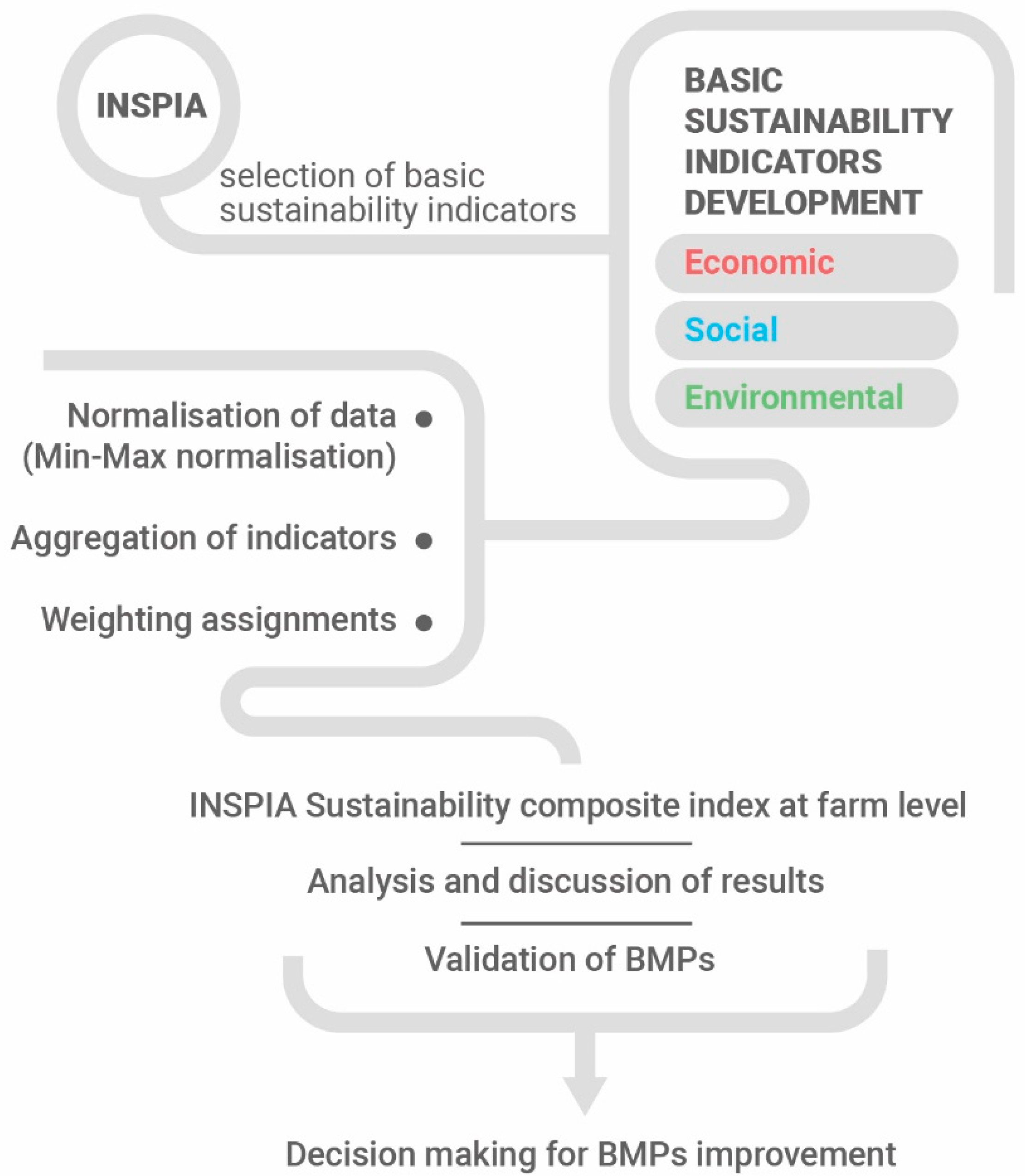
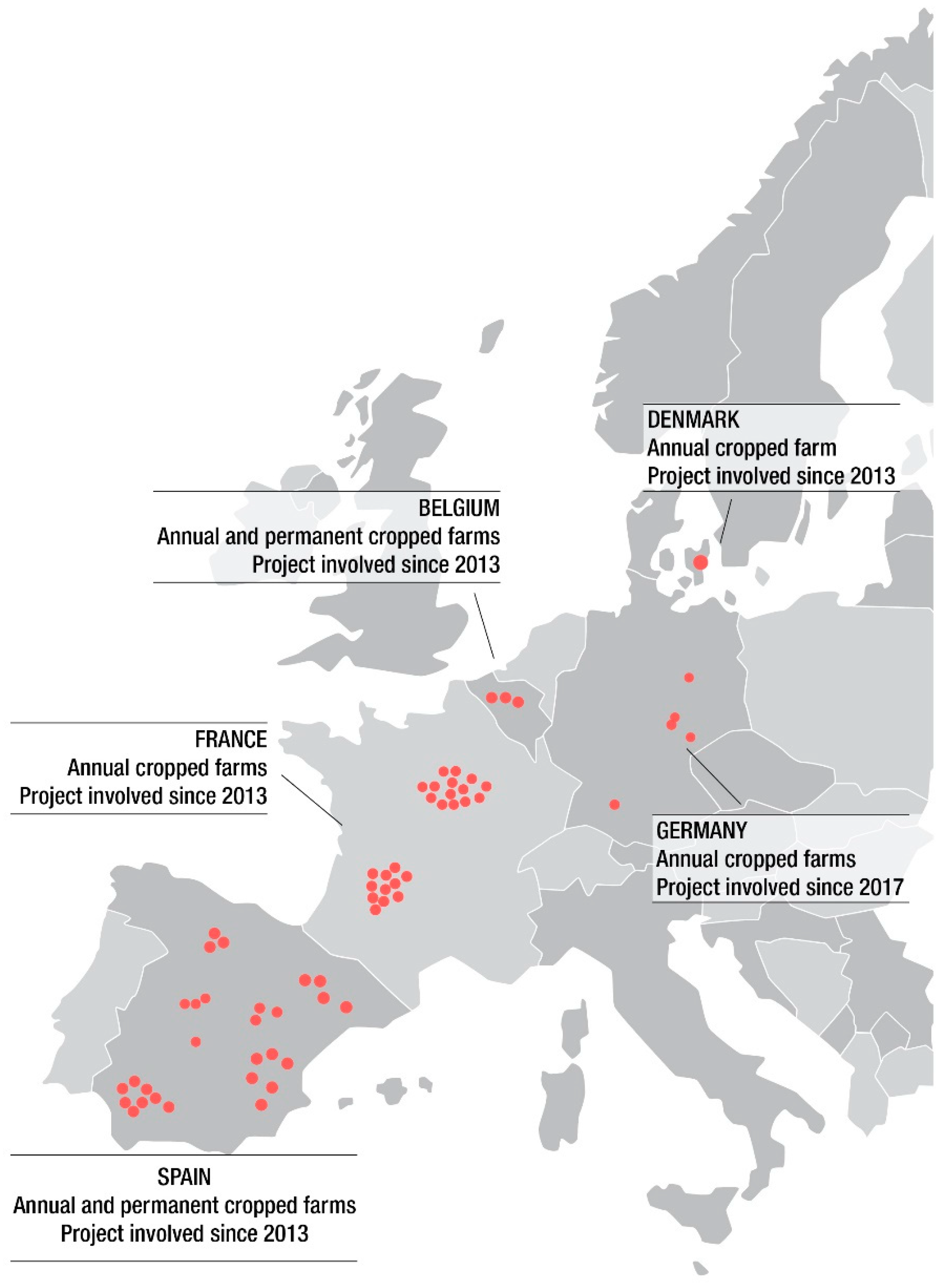
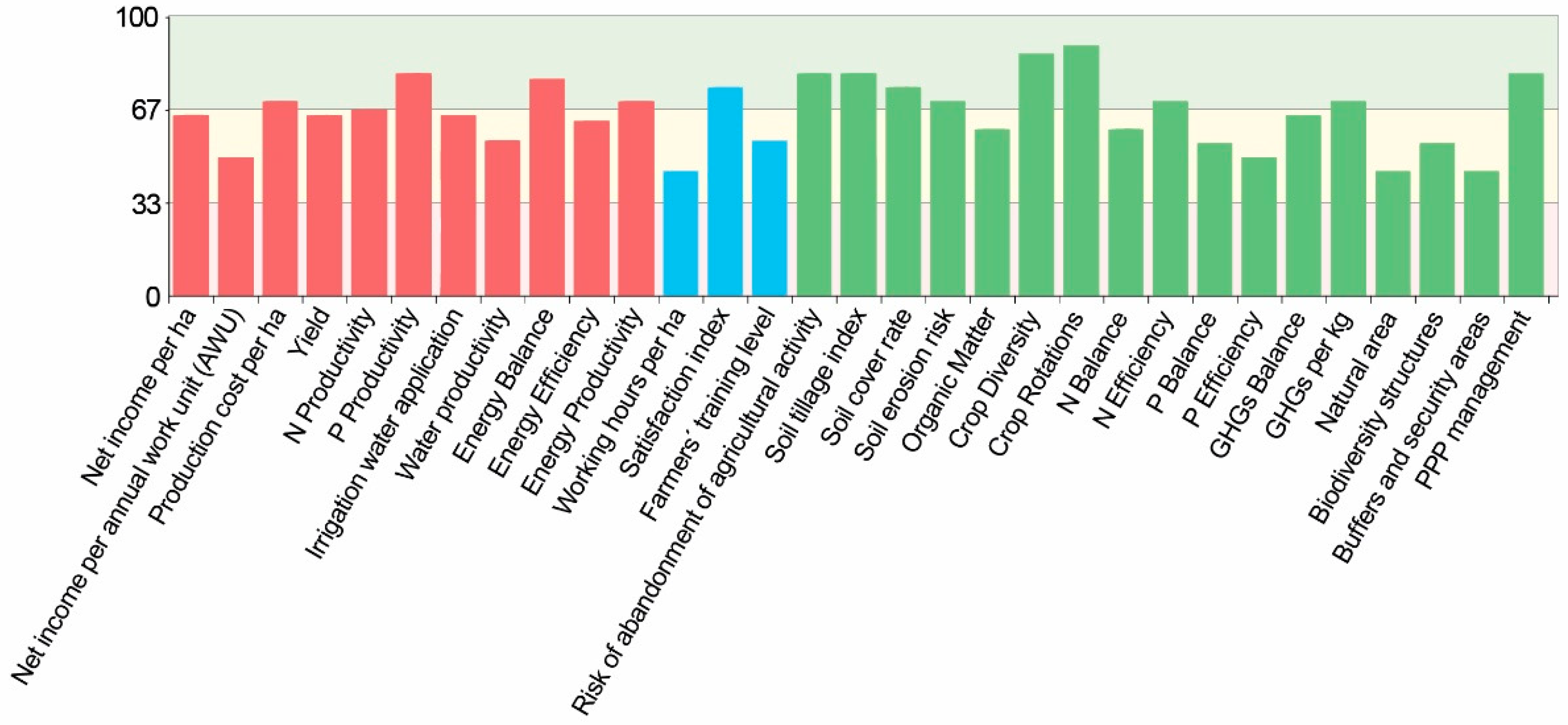
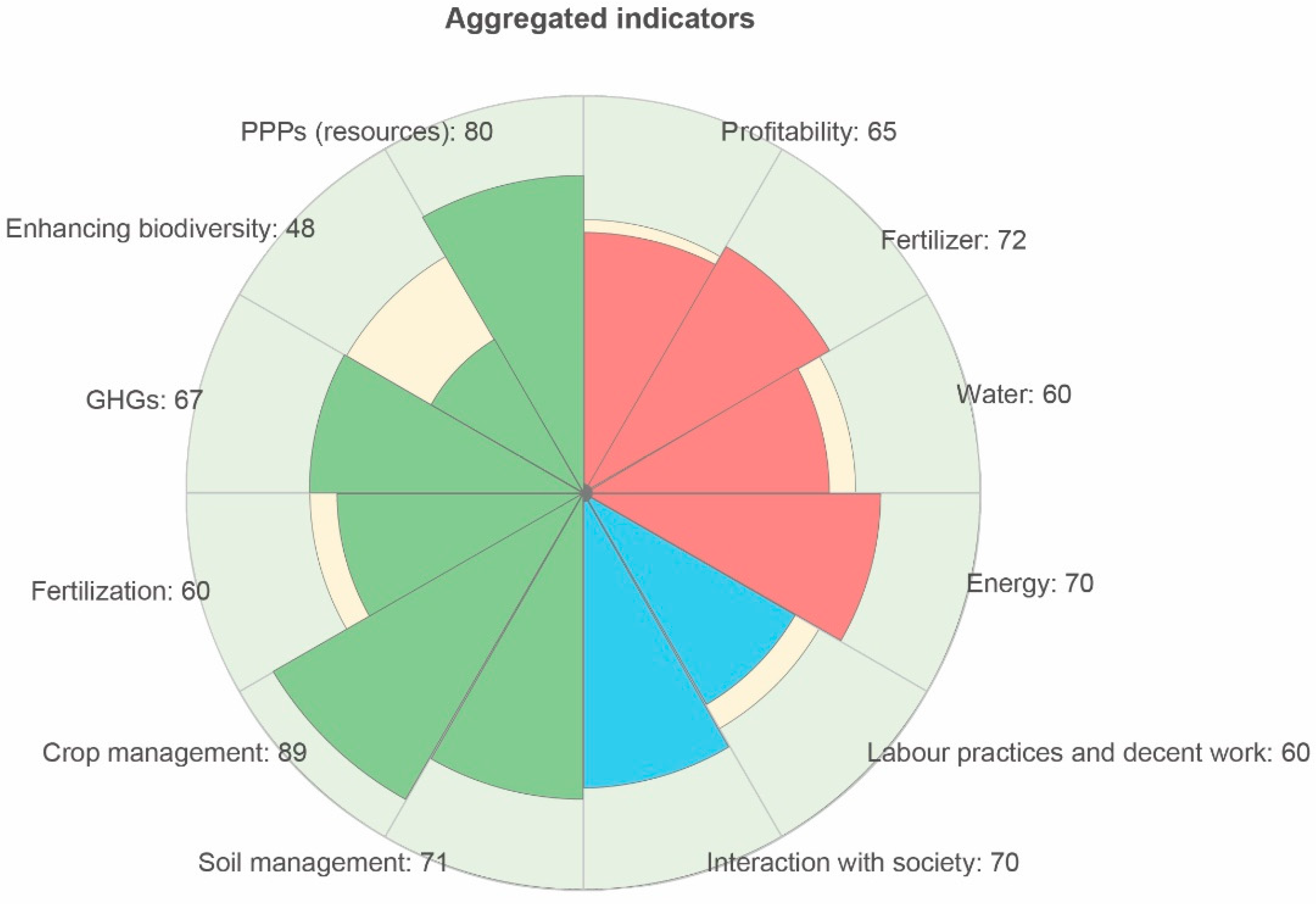
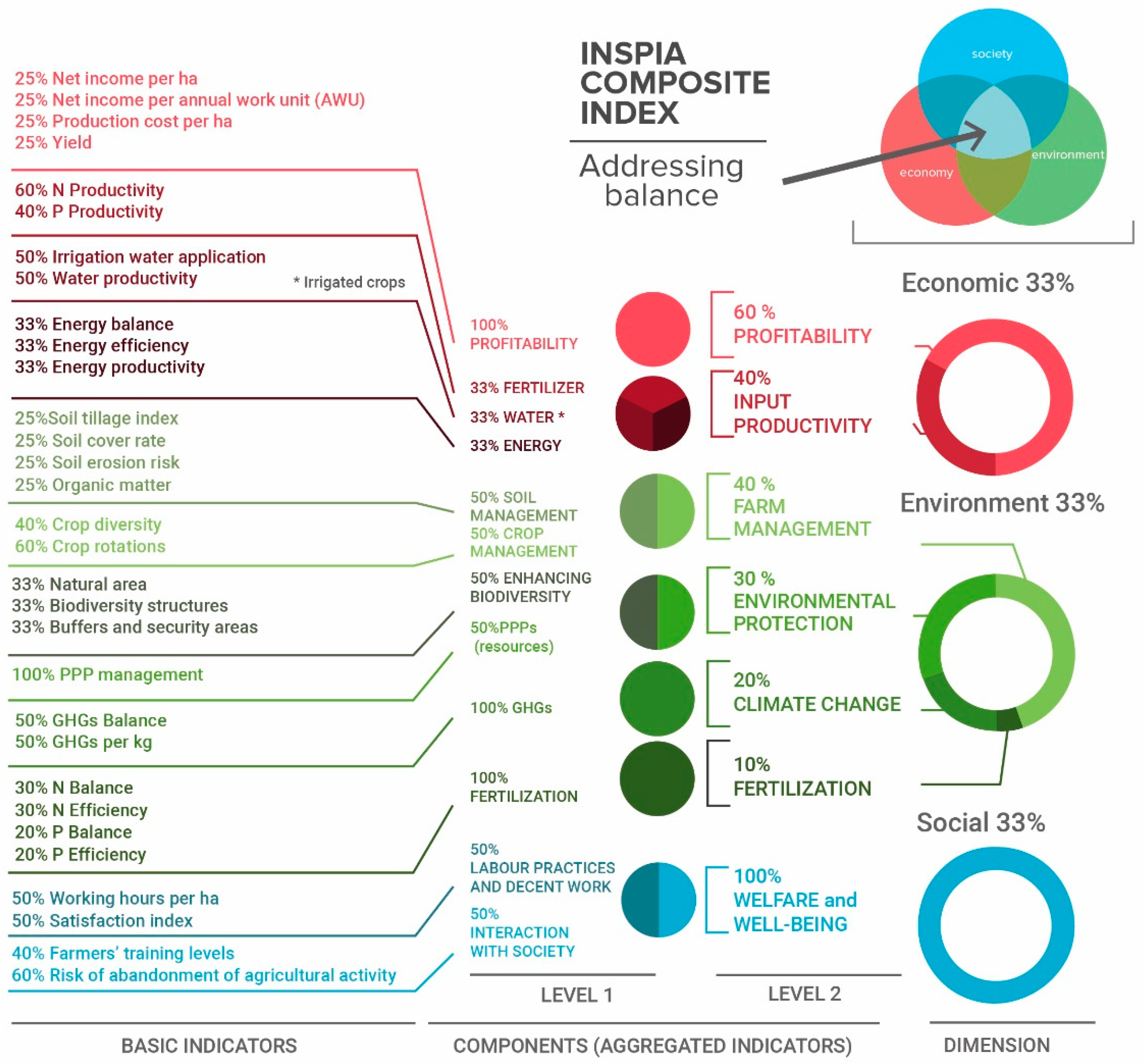

| BMP | Name of the INSPIA BMP |
|---|---|
| BMP 1 | Use permanent soil cover (green cover or residue cover). |
| BMP 2 | Use of minimum soil disturbance practices. |
| BMP 3 | Use of groundcovers (in permanent crops). |
| BMP 4 | Perform suitable crop rotation/diversification. |
| BMP 5 | Perform farming operations following the contour lines. |
| BMP 6 | Fertilize according to soil deficiencies and crop needs. |
| BMP 7 | Plant protection products use according to Integrated Pest Management (IPM) principles. |
| BMP 8 | Use of modern technologies for applications (precision agriculture). |
| BMP 9 | Optimise irrigation timing and rate (considering soil water content, water holding capacity in the soil, and crop requirements in relation to evapo-transpiration). |
| BMP 10 | Optimised use of pesticides (correct dose and appropriate product) |
| BMP 11 | Implementation of field margins and buffer strips with diversity of plant species. |
| BMP 12 | Establish and maintain riparian buffers. |
| BMP 13 | Build retention structures across slopes to reduce length of plots (fascines, vegetative buffers). |
| BMP 14 | Point source prevention of PPP (pesticide) pollution on the farm (establish areas to fill and clean sprayers and manage containers). |
| BMP 15 | Perform optimised waste management (packaging, crop residues, effluents, pesticide containers, etc.). |
| No. | INSPIA Basic Sustainability Indicators | Units | Sustainability Dimension (Thematic Scope) |
|---|---|---|---|
| 1 | Net income per ha | €/ha | Economic dimension |
| 2 | Net income per annual work unit (AWU) | €/AWU | |
| 3 | Production cost per ha | €/ha | |
| 4 | Yield | ||
| 5 | N Productivity | kg/kg | |
| 6 | P Productivity | kg/kg | |
| 7 | Irrigation water application | m3/ha | |
| 8 | Water productivity | kg/m3 | |
| 9 | Energy balance | MJ/ha | |
| 10 | Energy efficiency | MJ/MJ | |
| 11 | Energy productivity | kg/MJ | |
| 12 | Working hours per ha | h/ha | Social dimension |
| 13 | Satisfaction index | - | |
| 14 | Farmers’ training levels | - | |
| 15 | Risk of abandonment of agricultural activity | - | |
| 16 | Soil tillage index | - | Environmental dimension |
| 17 | Soil cover rate | - | |
| 18 | Organic matter | - | |
| 19 | Soil erosion risk | % | |
| 20 | Crop diversity | - | |
| 21 | Crop rotations | - | |
| 22 | N Balance | kg N/ha | |
| 23 | N Efficiency | kg/kg | |
| 24 | P Balance | kg P/ha | |
| 25 | P Efficiency | kg/kg | |
| 26 | GHGs Balance | CO2eq/ha | |
| 27 | GHGs per kg | Kg CO2eq/kg | |
| 28 | Natural area | % | |
| 29 | Biodiversity structures | - | |
| 30 | Buffers and security areas | % | |
| 31 | PPP management | - |
| INSPIA Basic Indicators | |||||||||||||||||||||||||||||||
|---|---|---|---|---|---|---|---|---|---|---|---|---|---|---|---|---|---|---|---|---|---|---|---|---|---|---|---|---|---|---|---|
| BMP | 1 | 2 | 3 | 4 | 5 | 6 | 7 | 8 | 9 | 10 | 11 | 12 | 13 | 14 | 15 | 16 | 17 | 18 | 19 | 20 | 21 | 22 | 23 | 24 | 25 | 26 | 27 | 28 | 29 | 30 | 31 |
| 1 | X | X | X | X | X | X | X | X | X | X | X | X | X | X | X | X | X | X | X | X | X | X | X | X | X | ||||||
| 2 | X | X | X | X | X | X | X | X | X | X | X | X | X | X | X | X | X | X | X | X | X | X | X | ||||||||
| 3 | X | X | X | X | X | X | X | X | X | X | X | X | X | X | X | X | X | X | X | X | X | X | X | X | X | ||||||
| 4 | X | X | X | X | X | X | X | X | X | X | X | X | X | X | X | X | X | X | X | X | X | X | X | X | X | X | X | X | |||
| 5 | X | X | |||||||||||||||||||||||||||||
| 6 | X | X | X | X | X | X | X | X | X | X | X | X | X | X | X | X | X | X | X | X | X | ||||||||||
| 7 | X | X | X | X | X | X | X | X | X | X | X | X | X | X | |||||||||||||||||
| 8 | X | X | X | X | X | X | X | X | X | X | X | X | X | X | X | X | X | X | X | X | X | X | |||||||||
| 9 | X | X | X | X | X | X | X | X | X | X | X | X | X | X | X | X | X | ||||||||||||||
| 10 | X | X | X | X | X | X | X | X | X | X | X | X | X | ||||||||||||||||||
| 11 | X | X | X | X | X | X | X | X | X | X | X | X | X | X | X | X | X | X | X | ||||||||||||
| 12 | X | X | X | X | X | X | X | X | X | X | X | X | X | X | X | X | X | X | X | ||||||||||||
| 13 | X | X | X | X | X | ||||||||||||||||||||||||||
| 14 | X | X | X | ||||||||||||||||||||||||||||
| 15 | X | X | X | ||||||||||||||||||||||||||||
| SDGs | |||||||||
|---|---|---|---|---|---|---|---|---|---|
| 2 | 4 | 6 | 7 | 8 | 9 | 12 | 13 | 15 | |
| BMP | Zero Hunger | Quality Education | Clean Water and Sanitation | Affordable and Clean Energy | Decent Work and Economic Growth | Industry, Innovation and Infrastructure | Responsible Consumption and Production | Climate Action | Life on Land |
| 1 | X | X | X | X | X | X | |||
| 2 | X | X | X | X | X | X | X | X | |
| 3 | X | X | X | X | X | X | |||
| 4 | X | X | X | X | X | X | X | ||
| 5 | X | X | X | ||||||
| 6 | X | X | X | X | X | X | X | X | |
| 7 | X | X | X | X | X | X | X | ||
| 8 | X | X | X | X | X | X | X | X | |
| 9 | X | X | X | X | X | X | X | X | |
| 10 | X | X | X | X | X | X | X | X | X |
| 11 | X | X | X | ||||||
| 12 | X | X | X | ||||||
| 13 | X | X | X | ||||||
| 14 | X | X | X | X | |||||
| 15 | X | X | X | ||||||
| INSPIA Basic Sustainability Indicators | Other Sustainability Methodologies | |
|---|---|---|
| 1 | Net income per ha | SAFE/DEXiPM/MOTIFS1/Gómez-Limón and Sanchez-Fernandez, 2010/IDEA2/MASC/MASC 2.0.3/RISE 3.0.4/SAEMETH/OECD/SOSTARE simplified |
| 2 | Net income per annual work unit (AWU) | MOTIFS/IDEA/MASC/MASC 2.0./OECD/SOSTARE simplified |
| 3 | Production cost per ha | DEXiPM/IDEA/MASC/MASC 2.0./OECD/SOSTARE simplified |
| 4 | Yield | MOTIFS/IDEA/MASC/MASC 2.0./RISE 3.0./SOSTARE simplified |
| 5 | N Productivity | DEXiPM/RISE 3.0./SAEMETH/OECD/SOSTARE simplified/IDEA/SAFE |
| 6 | P Productivity | DEXiPM/IDEA/MASC/MASC 2.0./RISE 3.0./SAEMETH/OECD/SOSTARE simplified/SAFE |
| 7 | Irrigation water application | SAFE/DEXiPM/Gómez-Limón and Sanchez-Fernandez, 2010/MOTIFS/MASC/MASC 2.0./RISE 3.0./SAFA/SAEMETH/OECD |
| 8 | Water productivity | Gómez-Limón and Sanchez-Fernandez, 2010/MASC/MASC 2.0./RISE 3.0./OECD/SOSTARE simplified/SAFE |
| 9 | Energy balance | SAFE/DEXiPM/Gómez-Limón and Sanchez-Fernandez, 2010/IDEA/MASC/MASC 2.0./RISE 3.0./SOSTARE simplified/INDIGO®/SAFE SAEMETH |
| 10 | Energy efficiency | DEXiPM/MOTIFS/IDEA/MASC/MASC 2.0./RISE 3.0./SOSTARE simplified/INDIGO®/SAFE/SAEMETH |
| 11 | Energy productivity | DEXiPM/MASC/MASC 2.0./RISE 3.0./SOSTARE simplified/INDIGO®/SAFE/SAEMETH |
| 12 | Working hours per ha | DEXiPM/Gómez-Limón and Sanchez-Fernandez, 2010/MASC 2.0./RISE 3.0./SAFA |
| 13 | Satisfaction index | IDEA/SAFA |
| 14 | Farmers’ training levels | SAFE/IDEA |
| 15 | Risk of abandonment of agricultural activity | SAFE |
| 16 | Soil tillage index | DEXiPM/RISE 3.0./SAFA/OECD/SOSTARE simplified/SAFE |
| 17 | Soil cover rate | SAFE/RISE 3.0./Gómez-Limón and Sanchez-Fernandez, 2010/OECD/SOSTARE simplified/INDIGO® |
| 18 | Soil erosion risk | MASC/MASC 2.0./IDEA/Gómez-Limón and Sanchez-Fernandez, 2010/SAFA/SAFE/RISE 3.0./OECD |
| 19 | Organic matter | DEXiPM/MOTIFS/IDEA/MASC/MASC 2.0./RISE 3.0./SAFA/SOSTARE simplified/INDIGO® |
| 20 | Crop diversity | DEXiPM/MOTIFS/IDEA/MASC/MASC 2.0./RISE 3.0./SAFA/INDIGO® |
| 21 | Crop rotations | Gómez-Limón and Sanchez-Fernandez, 2010/RISE 3.0./SAFA/MASC/MASC 2.0./SAEMETH/SOSTARE simplified |
| 22 | N Balance | SAFE/DEXiPM/Gómez-Limón and Sanchez-Fernandez, 2010/RISE 3.0./SAFA/SAEMETH/OECD/SOSTARE simplified/INDIGO®/IDEA |
| 23 | N Efficiency | DEXiPM/MOTIFS/RISE 3.0./SAFA/SAEMETH/OECD/SOSTARE simplified/INDIGO®/IDEA |
| 24 | P Balance | SAFE/DEXiPM/Gómez-Limón and Sanchez-Fernandez, 2010/IDEA/MASC/MASC 2.0./RISE 3.0./SAFA/SOSTARE simplified/SAEMETH/OECD/INDIGO® |
| 25 | P Efficiency | DEXiPM/MOTIFS/IDEA/MASC/MASC 2.0./RISE 3.0./SAFA/SAEMETH/OECD/SOSTARE simplified/INDIGO® |
| 26 | GHGs Balance | DEXiPM/MASC/MASC 2.0./RISE 3.0./SAFA/OECD/SAEMETH |
| 27 | GHGs per kg | DEXiPM/MASC/MASC 2.0./RISE 3.0./SAFA/OECD/SAEMETH |
| 28 | Natural area | MOTIFS/RISE 3.0./SAFA/SOSTARE simplified/IDEA/SAEMETH |
| 29 | Biodiversity structures | MOTIFS/RISE 3.0./SAFA/SAFE |
| 30 | Buffers and security areas | MOTIFS/RISE 3.0./SAFA/IDEA/SAFE |
| 31 | PPP management | MOTIFS/Gómez-Limón and Sanchez-Fernandez, 2010/IDEA/MASC/MASC 2.0./RISE 3.0./SAFA/SAEMETH/OECD/INDIGO® |
| Mutual Economic Indicators with INSPIA (11) | Common Ground on Economic Dimension (%) | Mutual Social Indicators with INSPIA (4) | Common Ground on Social Dimension (%) | Mutual Environmental Indicators with INSPIA (16) | Common Ground on Environmental Dimension (%) | Common Ground of Models (%) | |
|---|---|---|---|---|---|---|---|
| RISE 3.0. | 9 | 81.8 | 1 | 25.0 | 16 | 100.0 | 68.3 |
| DEXiPM | 4 | 36.4 | 1 | 25.0 | 9 | 56.3 | 38.8 |
| SAFA | 1 | 9.1 | 2 | 50.0 | 14 | 87.5 | 48.4 |
| OECD | 7 | 63.6 | 0 | 0,0 | 10 | 62.5 | 41.6 |
| SOSTARE simplified | 10 | 90.9 | 0 | 0,0 | 9 | 56.2 | 48.6 |
| Gómez-Limón and Sanchez-Fernandez | 4 | 36.4 | 1 | 25.0 | 6 | 37.5 | 32.6 |
| INDIGO® | 3 | 27.3 | 0 | 0.0 | 8 | 50.0 | 25.5 |
| MOTIFS | 5 | 45.5 | 0 | 0.0 | 8 | 50.0 | 31.5 |
| MASC | 10 | 90.9 | 0 | 0.0 | 9 | 56.3 | 48.6 |
| MASC 2.0. | 10 | 90.9 | 1 | 25.0 | 9 | 56.3 | 56.8 |
| IDEA | 8 | 72.7 | 2 | 50.0 | 10 | 62.5 | 61.1 |
| SAEMETH | 7 | 63.6 | 0 | 0.0 | 9 | 56.3 | 39.6 |
| SAFE | 9 | 81.8 | 2 | 50.0 | 7 | 43.8 | 57.9 |
| Sustainability Assessment Models | Number of basic Sustainability Indicators | Sustainability Dimensions Considered Agriculture Sustainability Assessment | Agriculture Sustainability Score Measurement Type |
|---|---|---|---|
| INDIGO® | 9 (0/0/9) | Environmental dimensión | |
| OECD, 2008 | 49 (13/9/8/19) | Agriculture in the broader economic, social and environmental context/Farm management and the environment/Use of farm inputs and natural resources/Environmental impacts of agriculture | |
| SAFE | 20 (14/1/5) | Environmental/Economic/Social pillars | |
| MOTIFS | 46 (21/7/18) | Economic (33)/Social (33)/Ecological themes (33) | 0 (Non sustainable) 100 (sustainable) per theme |
| IDEA | 41 (19/16/6) | Agro-ecological/Socio-territorial/Economic scale | Score between (0–100) |
| MASC | 32 (4/5/23) | Economic (33)/Social (33)/Environmental sustainability (33) | Very low/Low/Medium/High/Very high |
| MASC 2.0. | 39 (12/7/20) | Economic (33)/Social (33)/Environmental sustainability (33) | Very low/Low/Medium/High/Very high |
| Gómez-Limón and Sanchez-Fernandez, 2010 | 16 (3/4/9) | Economic/Social/Environmental function | |
| DEXiPM | 45 (6/18/21) | Economic/Social/Environmental sustainability | Very high/High/Medium/Low/Very low |
| RISE | 12 (7/4/1) | Ecological/Economical/Social | Value (−100–+100) |
| RISE 3.0. | Soil use/Animal husbandry/Material use and environmental protection/Water use/Energy and Climate/Biodiversity/Working conditions/Quality of life/Economic viability/Farm management % unknown | Problematic (0–33)/Critical (34–66)/Positive (67–100) | |
| SAFA | 116 (19/52/26/19) | Governance/Environmental/Economic/Social dimensions | Best (>80%)/Good (60–80)%/Moderate (40–60)%/Limited (20–40)%/Unacceptable (<20%) |
| SAEMETH | Socio-cultural (33%)/Agro-environmental (33%)/Economic dimensions (33%) | ||
| SOSTARE | 125 (92/27/6) | Agronomy/Economy/Ecology | Separately indicators referenced to thresholds |
© 2019 by the authors. Licensee MDPI, Basel, Switzerland. This article is an open access article distributed under the terms and conditions of the Creative Commons Attribution (CC BY) license (http://creativecommons.org/licenses/by/4.0/).
Share and Cite
Trivino-Tarradas, P.; Gomez-Ariza, M.R.; Basch, G.; Gonzalez-Sanchez, E.J. Sustainability Assessment of Annual and Permanent Crops: The Inspia Model. Sustainability 2019, 11, 738. https://doi.org/10.3390/su11030738
Trivino-Tarradas P, Gomez-Ariza MR, Basch G, Gonzalez-Sanchez EJ. Sustainability Assessment of Annual and Permanent Crops: The Inspia Model. Sustainability. 2019; 11(3):738. https://doi.org/10.3390/su11030738
Chicago/Turabian StyleTrivino-Tarradas, Paula, Manuel R. Gomez-Ariza, Gottlieb Basch, and Emilio J. Gonzalez-Sanchez. 2019. "Sustainability Assessment of Annual and Permanent Crops: The Inspia Model" Sustainability 11, no. 3: 738. https://doi.org/10.3390/su11030738
APA StyleTrivino-Tarradas, P., Gomez-Ariza, M. R., Basch, G., & Gonzalez-Sanchez, E. J. (2019). Sustainability Assessment of Annual and Permanent Crops: The Inspia Model. Sustainability, 11(3), 738. https://doi.org/10.3390/su11030738





